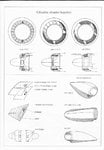A
Anonymous
Guest
No, those losses were for the entire "West", which includes all areas of conflict with the W. Allies.
On the "Western Front" (as opposed to defense of Germany or the MTO) the figures are:
Jan-May 1944 -
day fighters: strength = 259, losses = 1628
all aircraft: strength = 1240, losses = 3435
Jun-Oct 1944 -
day fighters: strength = 581, losses = 2714
all aircraft: strength = 1348, losses = 4696
=S=
Lunatic
On the "Western Front" (as opposed to defense of Germany or the MTO) the figures are:
Jan-May 1944 -
day fighters: strength = 259, losses = 1628
all aircraft: strength = 1240, losses = 3435
Jun-Oct 1944 -
day fighters: strength = 581, losses = 2714
all aircraft: strength = 1348, losses = 4696
=S=
Lunatic





